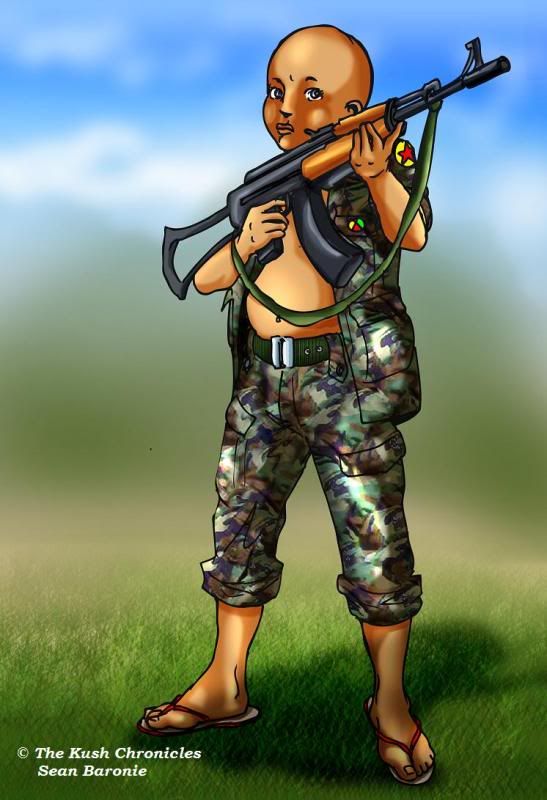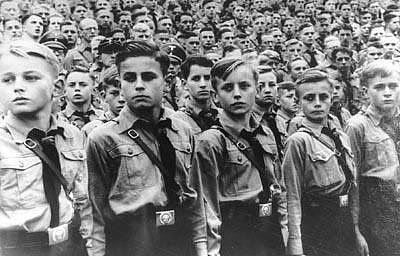The Murderous Innocents 2
Chronicled by
Afronuts
@
Thursday, April 29, 2010
Apparently, the issue of child soldiers has origins far back than I expected. After coming across this info, I came to realize that it was a phenomenon that pervaded almost any nation that went to war!

According to a report as stated by stolenchildhood.net, more than 120,000 children under 18 years of age have participated in armed conflicts across Africa. Some of these children are no more than 7 or 8 years of age.
Children as young as 10 worked as fighters, spies and domestic workers, some groups abducted girls into sexual slavery.
In addition to the obvious risks to children of participation in armed conflict - which apply equally to adults - children are often at an added disadvantage as combatants. As a result of being widely perceived to be dispensable commodities, they tend to receive little or no training before being thrust into the front line. Reports from Burundi and Congo-Brazzaville suggest that they are often massacred in combat as a result.

Image source
Throughout history and in many cultures, children have been extensively involved in military campaigns even when such practices were supposedly against cultural morals.
The earliest mentions of minors being involved in wars come from antiquity. It was customary for youths in the Mediterranean basin to serve as aides, charioteers and armor bearers to adult warriors. Examples of this practice can be found in the Bible (such as David's service to King Saul), in Hittite and Egyptian art, and in Greek mythology (such as the story of Hercules and Hylas), philosophy and literature.
Also in a practice dating back to antiquity, children were routinely taken on campaign, together with the rest of a military man's family, as part of the baggage. This exposed them to harm from rearguard attacks, such as the one at the battle of Agincourt, where the retainers and children of the English army were massacred by the French.
The Romans also made use of youths in war, though it was understood that it was unwise and cruel to use children in war, and Plutarch implies that regulations required youths to be at least sixteen years of age.
In medieval Europe, young boys from about twelve years of age were used as military aides ("squires"), though in theory their role in actual combat was limited. The so-called Children's Crusade in 1212 recruited thousands of children as untrained soldiers under the assumption that divine power would enable them to conquer the enemy, although none of the children actually entered combat; according to the legend, they were instead sold into slavery. While most scholars no longer believe that the Children's Crusade consisted solely, or even mostly, of children, it nonetheless exemplifies an era in which the entire family took part in a war effort.
Young boys often took part in battles during early modern warfare. One of their more visible roles was as the ubiquitous "drummer boy" – the film Waterloo (based on the Battle of Waterloo) graphically depicts French drummer boys leading Napoleon's initial attack, only to be gunned down by Allied soldiers.

*Drummer boy John Clem during the American Civil War
Image Source
During the age of sail, young boys formed part of the crew of British Royal Navy ships and were responsible for many important tasks including bringing powder and shot from the ship's magazine to the gun crews. These children were called "powder monkeys".
During the Siege of Mafeking in the Second Boer War, Robert Baden-Powell recruited and trained 12-15 year old boys as scouts, thus freeing up the limited number of men for the actual fighting. The boys' success led indirectly to Baden-Powell founding the Boy Scouts, a youth organization originally run along military lines. At the outbreak of the First World War, boys as young as 13 were caught up in the overwhelming tide of patriotism and in huge numbers cheerfully enlisted for active service others to avoid the harsh and dreary lives they had working in British industry. (Now you know the reason the Boys Scout was actaully formed!)
By a law signed by Nicholas I of Russia in 1827, a disproportionate number of Jewish boys, known as the cantonists, were forced into military training establishments to serve in the army. The 25-year conscription term officially commenced at the age of 18, but boys as young as eight were routinely taken to fulfill the hard quota.
In World War II, children frequently fought in insurrections. During the Holocaust, Jews of all ages, including teenagers participated in the Jewish resistance simply in order to survive.
A number of child soldiers served in the Soviet Union's armed forces during the war. In some cases, orphans also unofficially joined the Soviet Red Army. Such children were affectionately known as "son of the regiment" and sometimes willingly performed military missions such as reconnaissance.

*Hitler Youth (Hitlerjugend)
Image Source
On the opposite side, Hitler Youth (Hitlerjugend) was an organization in Nazi Germany that trained youth physically and indoctrinated them with Nazi ideology to the point of fanaticism. Lewis D. Eigen, in his article on the history of the "normality" of use of child soldiers observed:
"The Germans equipped an entire SS Panzer Tank Division and manned it with 16 and 17-year-old boys from the Hitler Youth brigades. As Germany suffered more casualties, more teenagers volunteered and were accepted, initially as reserve troops but then as regulars. The German ethic of the boy soldier not only encouraged such service but towards the end of the war, the Germans even drafted boys as young as 12 into military service. These children saw extensive action and were among the fiercest and effective German defenders in the Battle of Berlin."

*German kid prisoners of war in the streets of Berlin, May 1945
Image Source
In some cases, youth organizations were, and still are, militarized in order to instill discipline in their ranks, sometimes to indoctrinate them with propaganda and prepare for subsequent military service.
In preparation for the possible invasion of Japan by the Allies, Japanese military authorities also trained young teens to charge the enemy with bamboo spears. Prior to that, Japanese school children experienced increased military training introduced through their physical education classes, with military drills becoming a staple part of their curriculum.
There's so much info on the child soldier phenomenon but I've tried to simplify key info as much as possible from what I gathered. And I guess from the look of things, its not a new thing but something thats always been there and part of history.

*Sudanese child soldier
Image Source
I guess it makes sense to say, its a necessary evil that comes with wars, and I guess the more we reduce wars, the more we reduce the risk of annihilating future generations on bloody battlefields.

According to a report as stated by stolenchildhood.net, more than 120,000 children under 18 years of age have participated in armed conflicts across Africa. Some of these children are no more than 7 or 8 years of age.
Children as young as 10 worked as fighters, spies and domestic workers, some groups abducted girls into sexual slavery.
In addition to the obvious risks to children of participation in armed conflict - which apply equally to adults - children are often at an added disadvantage as combatants. As a result of being widely perceived to be dispensable commodities, they tend to receive little or no training before being thrust into the front line. Reports from Burundi and Congo-Brazzaville suggest that they are often massacred in combat as a result.

Image source
Throughout history and in many cultures, children have been extensively involved in military campaigns even when such practices were supposedly against cultural morals.
The earliest mentions of minors being involved in wars come from antiquity. It was customary for youths in the Mediterranean basin to serve as aides, charioteers and armor bearers to adult warriors. Examples of this practice can be found in the Bible (such as David's service to King Saul), in Hittite and Egyptian art, and in Greek mythology (such as the story of Hercules and Hylas), philosophy and literature.
Also in a practice dating back to antiquity, children were routinely taken on campaign, together with the rest of a military man's family, as part of the baggage. This exposed them to harm from rearguard attacks, such as the one at the battle of Agincourt, where the retainers and children of the English army were massacred by the French.
The Romans also made use of youths in war, though it was understood that it was unwise and cruel to use children in war, and Plutarch implies that regulations required youths to be at least sixteen years of age.
In medieval Europe, young boys from about twelve years of age were used as military aides ("squires"), though in theory their role in actual combat was limited. The so-called Children's Crusade in 1212 recruited thousands of children as untrained soldiers under the assumption that divine power would enable them to conquer the enemy, although none of the children actually entered combat; according to the legend, they were instead sold into slavery. While most scholars no longer believe that the Children's Crusade consisted solely, or even mostly, of children, it nonetheless exemplifies an era in which the entire family took part in a war effort.
Young boys often took part in battles during early modern warfare. One of their more visible roles was as the ubiquitous "drummer boy" – the film Waterloo (based on the Battle of Waterloo) graphically depicts French drummer boys leading Napoleon's initial attack, only to be gunned down by Allied soldiers.

*Drummer boy John Clem during the American Civil War
Image Source
During the age of sail, young boys formed part of the crew of British Royal Navy ships and were responsible for many important tasks including bringing powder and shot from the ship's magazine to the gun crews. These children were called "powder monkeys".
During the Siege of Mafeking in the Second Boer War, Robert Baden-Powell recruited and trained 12-15 year old boys as scouts, thus freeing up the limited number of men for the actual fighting. The boys' success led indirectly to Baden-Powell founding the Boy Scouts, a youth organization originally run along military lines. At the outbreak of the First World War, boys as young as 13 were caught up in the overwhelming tide of patriotism and in huge numbers cheerfully enlisted for active service others to avoid the harsh and dreary lives they had working in British industry. (Now you know the reason the Boys Scout was actaully formed!)
By a law signed by Nicholas I of Russia in 1827, a disproportionate number of Jewish boys, known as the cantonists, were forced into military training establishments to serve in the army. The 25-year conscription term officially commenced at the age of 18, but boys as young as eight were routinely taken to fulfill the hard quota.
In World War II, children frequently fought in insurrections. During the Holocaust, Jews of all ages, including teenagers participated in the Jewish resistance simply in order to survive.
A number of child soldiers served in the Soviet Union's armed forces during the war. In some cases, orphans also unofficially joined the Soviet Red Army. Such children were affectionately known as "son of the regiment" and sometimes willingly performed military missions such as reconnaissance.

*Hitler Youth (Hitlerjugend)
Image Source
On the opposite side, Hitler Youth (Hitlerjugend) was an organization in Nazi Germany that trained youth physically and indoctrinated them with Nazi ideology to the point of fanaticism. Lewis D. Eigen, in his article on the history of the "normality" of use of child soldiers observed:
"The Germans equipped an entire SS Panzer Tank Division and manned it with 16 and 17-year-old boys from the Hitler Youth brigades. As Germany suffered more casualties, more teenagers volunteered and were accepted, initially as reserve troops but then as regulars. The German ethic of the boy soldier not only encouraged such service but towards the end of the war, the Germans even drafted boys as young as 12 into military service. These children saw extensive action and were among the fiercest and effective German defenders in the Battle of Berlin."

*German kid prisoners of war in the streets of Berlin, May 1945
Image Source
In some cases, youth organizations were, and still are, militarized in order to instill discipline in their ranks, sometimes to indoctrinate them with propaganda and prepare for subsequent military service.
In preparation for the possible invasion of Japan by the Allies, Japanese military authorities also trained young teens to charge the enemy with bamboo spears. Prior to that, Japanese school children experienced increased military training introduced through their physical education classes, with military drills becoming a staple part of their curriculum.
There's so much info on the child soldier phenomenon but I've tried to simplify key info as much as possible from what I gathered. And I guess from the look of things, its not a new thing but something thats always been there and part of history.

*Sudanese child soldier
Image Source
I guess it makes sense to say, its a necessary evil that comes with wars, and I guess the more we reduce wars, the more we reduce the risk of annihilating future generations on bloody battlefields.

























7 Screamer(s):
Post a Comment